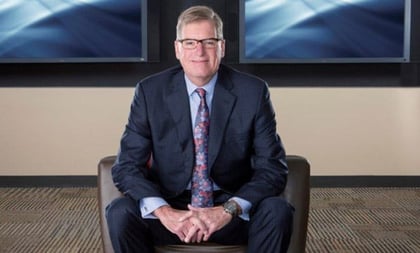Here’s a mini trend with mighty implications: Some intrepid Goldman Sachs wealth advisors are chucking their jobs at the illustrious bank to launch their own independent RIAs.
The shift, about two years old and gaining steam, is part of the larger trend of big teams with ultra-high assets under management opting, increasingly, to become independent registered advisors, Bernie J. Clark, executive vice president and head of Schwab Advisor Services, tells ThinkAdvisor in an interview.
Overseeing custody, trading and support services of the industry’s leading RIA custodian, Clark calls the Goldman departures “a bellwether” denoting the importance of the independent advisory space.
Schwab custodies for more than 7,500 RIAs. Nearly three out of four teams with AUM above $1 billion custody with the firm. One Goldman team that chose Schwab last year boasts AUM in excess of $16 billion, Clark says.
Large breakaways, especially from Goldman with its restrictive exit policies, give confidence to hesitant teams industry-wide to jump off that fence and finally go RIA. So says Clark, who joined Schwab in 1998 and has been running Advisor Services since 2010. A 30-year industry veteran, he earlier held posts at Deutsche Morgan Grenfell and Salomon Bros.
With a 30% market share and $1.6 trillion in client assets under management, Advisor Services, launched in 1987, is No. 1 of the Big Four custodians. The others are Fidelity, TD Ameritrade and BNY Mellon’s Pershing, according to Clark.
With no decline in the breakaway-broker exodus in sight, Schwab saw record breakaway growth last year: $30 billion of its $109 billion in net new assets came from wirehouse and broker-dealer FAs. Its previous top NNA increase was $70 billion.
In the interview, Clark reveals that not only are bigger, more sophisticated teams now entering the RIA space, many of these are merging to create ever-larger enterprises that are likely on the way to going national.
The hub from which Advisor Services provides custody, along with ongoing support and consulting for its clients, is located not in San Francisco corporate headquarters but in Phoenix, Arizona. In fact, more people work in Phoenix than in Schwab’s offices in the City by the Bay, where the firm was founded. Phoenix employs 1,700 dedicated to Advisor Services; another 4,000 folks there are in Schwab’s data center, retail operations and servicing groups. A total of 1,200 are employed in San Francisco.
ThinkAdvisor recently interviewed Clark, on the phone from Phoenix. Apart from discussing future RIA growth, he opined on whether giants like Google and Amazon — with their vast tech capabilities — would dare plunge into the wealth advisory industry. He also discussed whether Schwab considers Betterment, Wealthfront and other robo-advisors to be its competitors.
Here are excerpts:
THINKADVISOR: What’s new in the independent advisor arena?
BERNIE CLARK: This is different from what we’ve seen: We’re starting to see much, much larger teams coming into the space. We’ve had quite a few Goldman Sachs teams joining in the last two years, which was not as common. Originally you saw more Merrill Lynch and Morgan Stanley-type teams coming in. So this is a bit of a bellwether as to the importance of this space.
What can you share about the Goldman teams?
We had a team join us last year that has in excess of $16 billion in assets [under management]. They’re retaining a relationship with Goldman by staying invested in some of their products while also moving into the independent space.
How much M&A activity is occurring among RIAs?
I would have predicted that with all the regulation — cost and complexity — more small firms would be looking for M&A opportunities with other firms. As it turns out, we’re seeing a lot more M&A happening with billion-dollar firms coming together in mergers of equals to create larger firms. That’s going to strengthen and probably create more national footprints.
How is the structure of independent advisory firms changing?
They’ve matured a lot from being practices to becoming enterprises. It’s hard to find a successful firm that doesn’t have a chief compliance officer and a chief operations officer. So they’ve begun to get very serious about delineating responsibilities as opposed to just having founder-led companies, where the founder is the rainmaker [and wears other managerial hats too]. Those models are harder and harder to find.
In what other ways are advisors building their businesses?
More firms want to be multigenerational than ever before. This can be about creating equity events for partners within the firm to help the originating partners monetize.
Has the breakaway broker trend slowed down?
It’s actually increased. We saw record-breaking growth last year: $30 billion of our $109 billion in net new assets came from breakaways leaving institutions. It’s still a mix of those coming from hybrid independent broker-dealers and traditional wirehouses. Between 30% and 40% in any given year are coming from the broker-dealers.
Do any of those advisors retain a commission-based compensation system?
What we see is that more firms grow themselves out of the commission business because they want to have the moniker of “fiduciary.” They might come as a hybrid but may not remain one. The idea of being a fiduciary is something that’s extremely attractive to these breakaway teams.
A propos fiduciary, what are your thoughts about this summer’s demise of the Labor Department’s fiduciary rule for brokers?
It’s going to take the SEC quite some time to get around to crafting something that would even resemble what the DOL rule attempted to do.
What proportion of your clients are still partly compensated by commissions?









 July 17, 2018 at 01:37 PM
July 17, 2018 at 01:37 PM











